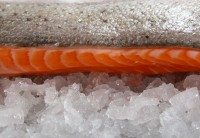By Lauren Goldberg, Staff Attorney—
When the fish we feed our families may contain toxic pollution, why do we see so few national headlines on toxics in fish? Maybe it’s because the problem has been around for a while. (Think Rachel Carson’s groundbreaking 1962 classic Silent Spring.) Or maybe it’s because we can’t see most toxic pollutants—many cause harm at levels in the parts per billion. Or that understanding why eating fish contaminated by toxic pollution harms brain development in fetuses or causes cancer in adults requires dredging up much loathed chemistry lessons from sophomore year in high school.
Earlier this month, I was pleasantly surprised to see The Huffington Post reporting on an issue well-deserving of national and regional attention: the pollution we put in Washington State rivers ends up on our dinner plates and we’re long overdue for major changes to rectify the problem. While many of us have the luxury of shifting our diets away from—or completely foregoing—otherwise healthy, often abundant, locally caught fish because of toxic contamination, this isn’t a solution. Low income families, immigrants with traditions deeply rooted in catching fish for the dinner table, and tribes who have fished the Northwest’s great rivers since time immemorial are disproportionately impacted by our society’s failure keep dangerous toxic pollutants out of our rivers and fish. Columbia Riverkeeper was actively involved in the multi-year effort, which culminated in a major win for public health, to convince Oregon to adopt accurate, protective toxic pollution limits. An excerpt from The Huffington Post article summarizes the latest movement to convince Washington State to rectify the injustice of allowing too much toxic pollution in local waterbodies:
One fillet of fish a month. That's about how much seafood a Washington State resident eats, according to the assumptions used to set cleanliness standards for the state's abundant rivers, streams, lakes and coastal waters. But many experts say that estimate, which influences the safety of the state's salmon, clams and other edible aquatic life, doesn't jive with reality.
"It's a gross underestimate," says Catherine O'Neill, a law school professor and faculty fellow at the Center for Indian Law and Policy at Seattle University. She said the one-fillet-a-month metric is too low for the general population, and an even worse estimate for the large number of Asian Americans and native tribes in the Pacific Northwest, for whom seafood plays a central dietary role.
"People are recommended to eat more fish than that, irrespective of culture," O'Neill tells The Huffington Post. The American Health Association advises eating the omega-3-rich food at least twice a week.
Although many give little thought to the great injustice of allowing toxics to accumulate in local fish, we’re hoping to change that. Convincing decision-makers to care about this issue starts with getting it in the public eye. To learn more about Riverkeeper's work in Washington state, read: Why Isn't Washington State Doing More to Protect People from Toxics in Fish? Also, check out Riverkeeper's Q&A fact sheet on this issue.



